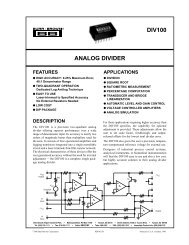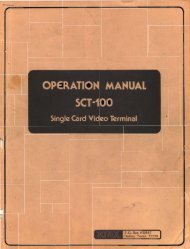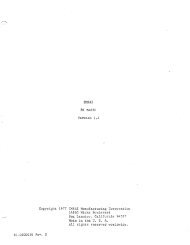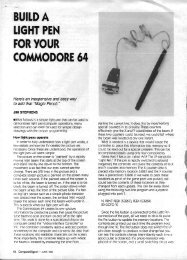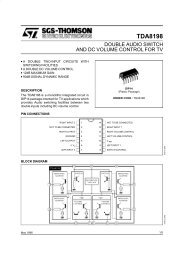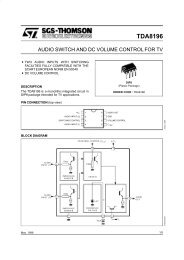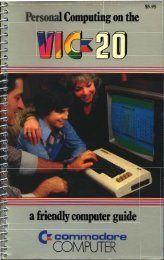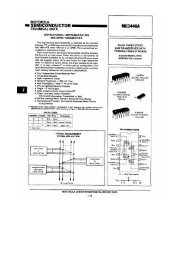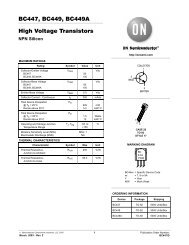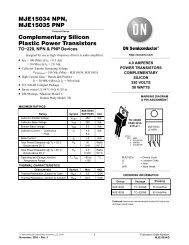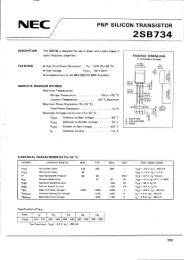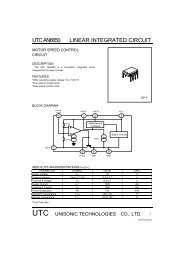- Page 1 and 2: Virtuoso The Virtual Single Proces
- Page 3 and 4: Table of Contents Introduction INT
- Page 5 and 6: Simulation in the control loop ....
- Page 7 and 8: KS_ResetSema ......................
- Page 9 and 10: Semaphores ........................
- Page 11 and 12: KS_EnableISR ......................
- Page 13 and 14: Preserved Registers ...............
- Page 15 and 16: Addressing Modes ..................
- Page 17 and 18: Introduction Introduction Virtuoso
- Page 19 and 20: Release notes Release notes V.3.01
- Page 21 and 22: Implementation-Specific Features Im
- Page 23 and 24: The history of Virtuoso The history
- Page 25 and 26: Manual Format Manual Format PART 1
- Page 27 and 28: License agreement License agreement
- Page 29 and 30: License agreement notice shall not
- Page 31 and 32: License agreement submits to jurisd
- Page 33 and 34: License agreement RETURN A SIGNED C
- Page 35 and 36: Virtuoso The Virtual Single Proces
- Page 37 and 38: Installation 1. Installation 1.1. I
- Page 39 and 40: Installation 5. Run the final demon
- Page 41: Installation 1.7. The final referen
- Page 45 and 46: Virtuoso : an overview 3.2.2. Class
- Page 47 and 48: Virtuoso : an overview 3.3. A multi
- Page 49 and 50: Virtuoso : an overview task switch
- Page 51 and 52: Virtuoso : an overview An ISR enter
- Page 53 and 54: Functional support from Virtuoso of
- Page 55 and 56: Functional support from Virtuoso Th
- Page 57 and 58: Functional support from Virtuoso ex
- Page 59 and 60: Functional support from Virtuoso al
- Page 61 and 62: Functional support from Virtuoso (c
- Page 63 and 64: Functional support from Virtuoso Me
- Page 65 and 66: Functional support from Virtuoso da
- Page 67 and 68: Functional support from Virtuoso me
- Page 69 and 70: Functional support from Virtuoso In
- Page 71 and 72: Functional support from Virtuoso 4.
- Page 73 and 74: Functional support from Virtuoso ru
- Page 75 and 76: Functional support from Virtuoso sy
- Page 77 and 78: Simple Examples /* resource node */
- Page 79 and 80: Simple Examples The sender task is
- Page 81 and 82: Applications from the start on, add
- Page 83 and 84: Virtuoso The Virtual Single Proces
- Page 85 and 86: Virtuoso microkernel types & data s
- Page 87 and 88: Virtuoso microkernel types & data s
- Page 89 and 90: Virtuoso microkernel types & data s
- Page 91 and 92: Virtuoso microkernel types & data s
- Page 93 and 94:
Virtuoso microkernel services 8. Vi
- Page 95 and 96:
Virtuoso microkernel services ■ c
- Page 97 and 98:
Virtuoso microkernel services ■ i
- Page 99 and 100:
Virtuoso microkernel services ■ a
- Page 101 and 102:
Virtuoso microkernel services ■ s
- Page 103 and 104:
Nanokernel types and datastructures
- Page 105 and 106:
Nanokernel services 10. Nanokernel
- Page 107 and 108:
Alphabetical List of Virtuoso micro
- Page 109 and 110:
Alphabetical List of Virtuoso micro
- Page 111 and 112:
Alphabetical List of Virtuoso micro
- Page 113 and 114:
Alphabetical List of Virtuoso micro
- Page 115 and 116:
Alphabetical List of Virtuoso micro
- Page 117 and 118:
Alphabetical List of Virtuoso micro
- Page 119 and 120:
Alphabetical List of Virtuoso micro
- Page 121 and 122:
Alphabetical List of Virtuoso micro
- Page 123 and 124:
Alphabetical List of Virtuoso micro
- Page 125 and 126:
Alphabetical List of Virtuoso micro
- Page 127 and 128:
Alphabetical List of Virtuoso micro
- Page 129 and 130:
Alphabetical List of Virtuoso micro
- Page 131 and 132:
Alphabetical List of Virtuoso micro
- Page 133 and 134:
Alphabetical List of Virtuoso micro
- Page 135 and 136:
Alphabetical List of Virtuoso micro
- Page 137 and 138:
Alphabetical List of Virtuoso micro
- Page 139 and 140:
Alphabetical List of Virtuoso micro
- Page 141 and 142:
Alphabetical List of Virtuoso micro
- Page 143 and 144:
Alphabetical List of Virtuoso micro
- Page 145 and 146:
Alphabetical List of Virtuoso micro
- Page 147 and 148:
Alphabetical List of Virtuoso micro
- Page 149 and 150:
Alphabetical List of Virtuoso micro
- Page 151 and 152:
Alphabetical List of Virtuoso micro
- Page 153 and 154:
Alphabetical List of Virtuoso micro
- Page 155 and 156:
Alphabetical List of Virtuoso micro
- Page 157 and 158:
Alphabetical List of Virtuoso micro
- Page 159 and 160:
Alphabetical List of Virtuoso micro
- Page 161 and 162:
Alphabetical List of Virtuoso micro
- Page 163 and 164:
Alphabetical List of Virtuoso micro
- Page 165 and 166:
Alphabetical List of Virtuoso micro
- Page 167 and 168:
Alphabetical List of Virtuoso micro
- Page 169 and 170:
Alphabetical List of Virtuoso micro
- Page 171 and 172:
Alphabetical List of Virtuoso micro
- Page 173 and 174:
Alphabetical List of Virtuoso micro
- Page 175 and 176:
Alphabetical List of Virtuoso micro
- Page 177 and 178:
Alphabetical List of Virtuoso micro
- Page 179 and 180:
Alphabetical List of Virtuoso micro
- Page 181 and 182:
Alphabetical List of Virtuoso micro
- Page 183 and 184:
Alphabetical List of Virtuoso micro
- Page 185 and 186:
Alphabetical List of Virtuoso micro
- Page 187 and 188:
Alphabetical List of Virtuoso micro
- Page 189 and 190:
Alphabetical List of Virtuoso micro
- Page 191 and 192:
Alphabetical List of Virtuoso micro
- Page 193 and 194:
Alphabetical List of Virtuoso micro
- Page 195 and 196:
Alphabetical List of Virtuoso micro
- Page 197 and 198:
Alphabetical List of Virtuoso micro
- Page 199 and 200:
Alphabetical List of Virtuoso micro
- Page 201 and 202:
Alphabetical List of Virtuoso micro
- Page 203 and 204:
Hostserver and netloader 12. Hostse
- Page 205 and 206:
Hostserver and netloader 12.2.2. Li
- Page 207 and 208:
Hostserver and netloader 12.3. Host
- Page 209 and 210:
Hostserver and netloader Driver Use
- Page 211 and 212:
Runtime libraries int fputc ( int c
- Page 213 and 214:
Runtime libraries int vsprintf ( ch
- Page 215 and 216:
Runtime libraries the graphics libr
- Page 217 and 218:
Runtime libraries void setfillstyle
- Page 219 and 220:
Runtime libraries void circle ( int
- Page 221 and 222:
Runtime libraries 13.2.6. Text plot
- Page 223 and 224:
System Configuration 14. System Con
- Page 225 and 226:
System Configuration NETLINK ROOT
- Page 227 and 228:
System Configuration should be defi
- Page 229 and 230:
System Configuration < : unidirecti
- Page 231 and 232:
System Configuration Processor Numb
- Page 233 and 234:
System Configuration The number mus
- Page 235 and 236:
System Configuration /* * the size
- Page 237 and 238:
Debugging environment under Virtuos
- Page 239 and 240:
Debugging environment under Virtuos
- Page 241 and 242:
Debugging environment under Virtuos
- Page 243 and 244:
Debugging environment under Virtuos
- Page 245 and 246:
Debugging environment under Virtuos
- Page 247 and 248:
Debugging environment under Virtuos
- Page 249 and 250:
Debugging environment under Virtuos
- Page 251 and 252:
Debugging environment under Virtuos
- Page 253 and 254:
Practical hints for correct use 16.
- Page 255 and 256:
Practical hints for correct use If
- Page 257 and 258:
Practical hints for correct use len
- Page 259 and 260:
Microkernel C++ interface 17. Micro
- Page 261 and 262:
Microkernel C++ interface first cha
- Page 263 and 264:
Microkernel C++ interface the name
- Page 265 and 266:
Microkernel C++ interface class KMa
- Page 267 and 268:
Microkernel C++ interface class KQu
- Page 269 and 270:
Microkernel C++ interface class KRe
- Page 271 and 272:
Microkernel C++ interface versions
- Page 273 and 274:
Microkernel C++ interface vkobjcts.
- Page 275 and 276:
Microkernel C++ interface test1.cpp
- Page 277 and 278:
Microkernel C++ interface ... test1
- Page 279 and 280:
Microkernel C++ interface test1.cpp
- Page 281 and 282:
Virtuoso The Virtual Single Proces
- Page 283 and 284:
Virtuoso on the Analog Devices 2102
- Page 285 and 286:
Virtuoso on the Analog Devices 2102
- Page 287 and 288:
Virtuoso on the Analog Devices 2102
- Page 289 and 290:
Virtuoso on the Analog Devices 2102
- Page 291 and 292:
Virtuoso on the Analog Devices 2102
- Page 293 and 294:
Virtuoso on the Analog Devices 2102
- Page 295 and 296:
Virtuoso on the Analog Devices 2102
- Page 297 and 298:
Virtuoso on the Analog Devices 2102
- Page 299 and 300:
Virtuoso on the Analog Devices 2102
- Page 301 and 302:
Virtuoso on the Analog Devices 2102
- Page 303 and 304:
Virtuoso on the Analog Devices 2102
- Page 305 and 306:
Virtuoso on the Analog Devices 2102
- Page 307 and 308:
Virtuoso on the Analog Devices 2102
- Page 309 and 310:
Virtuoso on the Analog Devices 2102
- Page 311 and 312:
Virtuoso on the Analog Devices 2102
- Page 313 and 314:
Alphabetical List of nanokernel ent
- Page 315 and 316:
Alphabetical List of nanokernel ent
- Page 317 and 318:
Alphabetical List of nanokernel ent
- Page 319 and 320:
Alphabetical List of nanokernel ent
- Page 321 and 322:
Alphabetical List of nanokernel ent
- Page 323 and 324:
Alphabetical List of nanokernel ent
- Page 325 and 326:
Alphabetical List of nanokernel ent
- Page 327 and 328:
Alphabetical List of nanokernel ent
- Page 329 and 330:
Alphabetical List of nanokernel ent
- Page 331 and 332:
Predefined drivers ing 14 can delay
- Page 333 and 334:
Predefined drivers Signal/Wait (2)
- Page 335 and 336:
Predefined drivers LINKFILE:list of
- Page 337 and 338:
Virtuoso on the ADSP 2106x SHARC 21
- Page 339 and 340:
Virtuoso on the ADSP 2106x SHARC 21
- Page 341 and 342:
Virtuoso on the ADSP 2106x SHARC .e
- Page 343 and 344:
Virtuoso on the ADSP 2106x SHARC 21
- Page 345 and 346:
Virtuoso on the ADSP 2106x SHARC 21
- Page 347 and 348:
Virtuoso on the ADSP 2106x SHARC 21
- Page 349 and 350:
Virtuoso on the ADSP 2106x SHARC of
- Page 351 and 352:
Virtuoso on the ADSP 2106x SHARC 21
- Page 353 and 354:
Virtuoso on the ADSP 2106x SHARC ..
- Page 355 and 356:
Alphabetical List of nanokernel ent
- Page 357 and 358:
Alphabetical List of nanokernel ent
- Page 359 and 360:
Alphabetical List of nanokernel ent
- Page 361 and 362:
Alphabetical List of nanokernel ent
- Page 363 and 364:
Alphabetical List of nanokernel ent
- Page 365 and 366:
Alphabetical List of nanokernel ent
- Page 367 and 368:
Alphabetical List of nanokernel ent
- Page 369 and 370:
Alphabetical List of nanokernel ent
- Page 371 and 372:
Predefined drivers 23. Predefined d
- Page 373 and 374:
Predefined drivers 23.1.2. The host
- Page 375 and 376:
Predefined drivers ■ speed: SSPEE
- Page 377 and 378:
Task Level Timings signal to waitm
- Page 379 and 380:
Application development hints. obje
- Page 381 and 382:
Virtuoso on the Intel 80x86 26. Vir
- Page 383 and 384:
Virtuoso on the Motorola 56K DSP 27
- Page 385 and 386:
Virtuoso on the Motorola 56K DSP 27
- Page 387 and 388:
Virtuoso on the Motorola 56K DSP 27
- Page 389 and 390:
Virtuoso on the Motorola 56K DSP Th
- Page 391 and 392:
Virtuoso on the Motorola 56K DSP $0
- Page 393 and 394:
Virtuoso on the Motorola 56K DSP Re
- Page 395 and 396:
Virtuoso on the Motorola 56K DSP Fo
- Page 397 and 398:
Virtuoso on the Motorola 56K DSP Th
- Page 399 and 400:
Virtuoso on the Motorola 56K DSP mo
- Page 401 and 402:
Virtuoso on the Motorola 56K DSP 27
- Page 403 and 404:
Virtuoso on the Motorola 56K DSP 27
- Page 405 and 406:
Virtuoso on the Motorola 56K DSP 27
- Page 407 and 408:
Virtuoso on the Motorola 56K DSP in
- Page 409 and 410:
Virtuoso on the Motorola 56K DSP Th
- Page 411 and 412:
Virtuoso on the Motorola 68030 syst
- Page 413 and 414:
Virtuoso on the Motorola 68030 syst
- Page 415 and 416:
Virtuoso on the Motorola 68030 syst
- Page 417 and 418:
Virtuoso on the Motorola 68030 syst
- Page 419 and 420:
Virtuoso on the Motorola 68030 syst
- Page 421 and 422:
Virtuoso on the Motorola 68030 syst
- Page 423 and 424:
Virtuoso on the Motorola 96K DSP 29
- Page 425 and 426:
Virtuoso on the Motorola 96K DSP Ad
- Page 427 and 428:
Virtuoso on the Motorola 96K DSP 95
- Page 429 and 430:
Virtuoso on the Motorola 96K DSP 29
- Page 431 and 432:
Virtuoso on the Motorola 96K DSP ru
- Page 433 and 434:
Virtuoso on the Motorola 96K DSP 29
- Page 435 and 436:
Virtuoso on the Motorola 96K DSP ;
- Page 437 and 438:
Virtuoso on the Motorola 96K DSP 29
- Page 439 and 440:
Virtuoso on the Motorola 96K DSP mo
- Page 441 and 442:
Virtuoso on the Motorola 96K DSP 29
- Page 443 and 444:
Virtuoso on the Motorola 96K DSP 29
- Page 445 and 446:
Virtuoso on the Motorola 96K DSP 29
- Page 447 and 448:
Virtuoso on the Motorola 96K DSP 29
- Page 449 and 450:
Virtuoso on the Motorola 96K DSP 12
- Page 451 and 452:
Virtuoso on the Motorola 96K DSP wh
- Page 453 and 454:
Virtuoso on the Motorola 68HC11. 30
- Page 455 and 456:
Virtuoso on the Motorola 68HC16 mic
- Page 457 and 458:
Virtuoso on the Mips R3000 systems.
- Page 459 and 460:
Virtuoso on the INMOS T2xx, T4xx, T
- Page 461 and 462:
Virtuoso on the INMOS T2xx, T4xx, T
- Page 463 and 464:
Virtuoso on the INMOS T2xx, T4xx, T
- Page 465 and 466:
Virtuoso on the INMOS T2xx, T4xx, T
- Page 467 and 468:
Virtuoso on the INMOS T2xx, T4xx, T
- Page 469 and 470:
Virtuoso on the INMOS T2xx, T4xx, T
- Page 471 and 472:
Virtuoso on the INMOS T2xx, T4xx, T
- Page 473 and 474:
Virtuoso on the INMOS T2xx, T4xx, T
- Page 475 and 476:
Virtuoso on the INMOS T9000 transpu
- Page 477 and 478:
Virtuoso on the Texas Instruments T
- Page 479 and 480:
Virtuoso on the Texas Instruments T
- Page 481 and 482:
Virtuoso on the Texas Instruments T
- Page 483 and 484:
Virtuoso on the Texas Instruments T
- Page 485 and 486:
Virtuoso on the Texas Instruments T
- Page 487 and 488:
Virtuoso on the Texas Instruments T
- Page 489 and 490:
Virtuoso on the Texas Instruments T
- Page 491 and 492:
Virtuoso on the Texas Instruments T
- Page 493 and 494:
Virtuoso on the Texas Instruments T
- Page 495 and 496:
Virtuoso on the Texas Instruments T
- Page 497 and 498:
Virtuoso on the Texas Instruments T
- Page 499 and 500:
Programming the nanokernel actually
- Page 501 and 502:
Programming the nanokernel The func
- Page 503 and 504:
Programming the nanokernel The L_CH
- Page 505 and 506:
Programming the nanokernel call. If
- Page 507 and 508:
Programming the nanokernel nal stat
- Page 509 and 510:
Programming the nanokernel tasks to
- Page 511 and 512:
Programming the nanokernel 1. The f
- Page 513 and 514:
Alphabetical List of nanokernel ent
- Page 515 and 516:
Alphabetical List of nanokernel ent
- Page 517 and 518:
Alphabetical List of nanokernel ent
- Page 519 and 520:
Alphabetical List of nanokernel ent
- Page 521 and 522:
Alphabetical List of nanokernel ent
- Page 523 and 524:
Alphabetical List of nanokernel ent
- Page 525 and 526:
Alphabetical List of nanokernel ent
- Page 527 and 528:
Alphabetical List of nanokernel ent
- Page 529 and 530:
Alphabetical List of nanokernel ent
- Page 531 and 532:
Alphabetical List of nanokernel ent
- Page 533 and 534:
Alphabetical List of nanokernel ent
- Page 535 and 536:
Alphabetical List of nanokernel ent
- Page 537 and 538:
Alphabetical List of nanokernel ent
- Page 539 and 540:
Predefined drivers ment the PC inte
- Page 541 and 542:
Glossary Abort (task) API Class Deb
- Page 543 and 544:
Process Queue Resource Semaphore /S
- Page 545 and 546:
Index Numerics 21020 relevant docum
- Page 547 and 548:
KS_Enqueue P2 - 42 KS_EnqueueW P2 -
- Page 549 and 550:
estorecrtmode P2 - 133 routing tabl




